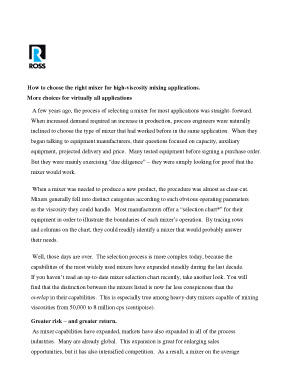How to choose the right mixer for high-viscosity mixing applications
A few years ago, the process of selecting a mixer for most applications was straight- forward. When increased demand required an increase in production, process engineers were naturally inclined to choose the type of mixer that had worked before in the same application. When they began talking to equipment manufacturers, their questions focused on capacity, auxiliary equipment, projected delivery and price. Many tested equipment before signing a purchase order. But they were mainly exercising "due diligence" -they were simply looking for proof that the mixer would work.
When a mixer was needed to produce a new product, the procedure was almost as clear-cut. Mixers generally fell into distinct categories according to such obvious operating parameters as the viscosity they could handle. Most manufacturers offer a "selection chart*" for their equipment in order to illustrate the boundaries of each mixer's operation. By tracing rows and columns on the chart, they could readily identify a mixer that would probably answer their needs.
Well, those days are over. The selection process is more complex today, because the capabilities of the most widely used mixers have expanded steadily during the lastdecade. If you haven't read an up-to-date mixer selection chart recently, take anotherlook. You will find that the distinction between the mixers listed is now far less conspicuous than the overlapin their capabilities. This is especially true among heavy-duty mixerscapable of mixing viscosities from 50,000 to 8 million cps (centipoise).






















































